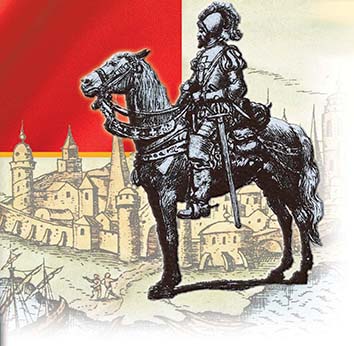SECTION 1: Spain’s Empire in the Americas

◄ Francisco Vásquez de Coronado
WITNESS HISTORY  AUDIO
AUDIO
Cities of Gold
In 1540, the Spanish explorer Francisco Vásquez de Coronado, along with 300 soldiers, set out to find Cibola, one of the fabled Seven Cities of Gold. Hoping to discover riches that equaled those found in Mexico, the expedition journeyed into the lands north of Mexico (the present-day U.S. Southwest). Instead of Cibola, the group found:
“… a little, crowded village, looking as if it had been crumpled all up together. There are ranch houses in New Spain which make a better appearance at a distance. It is a village of about 200 warriors….”
—Pedro de Casteneda, The Journey of Coronado, 1596
Disappointment turned to rage as Coronado’s men searched the village for gold. When they found none, they attacked the village, defeating it in about an hour.
Objectives
- Explain Spanish explorers’ achievements.
- Describe Spanish society in New Spain and Peru.
- Evaluate the causes and effects of Spanish imperial policies in the American Southwest.
Terms and People
- missionary
- presidio
- viceroy
- mestizo
- mission
NoteTaking
Reading Skill: Summarize Complete a concept web to summarize how each item strengthened the Spanish American Empire.

Spanish America
Missions
Presidios
Explorers
Native Americans
Why It Matters During the sixteenth century, the Spanish created a great empire by conquering and colonizing the lands in the Caribbean as well as large portions of North and South America. This American empire was more than ten times larger than Spain and rich in gold and silver. The potential for great wealth motivated other European nations to join the quest for colonies in the Americas. Soon rivalries emerged in the Americas as European empires vied for territory. Section Focus Question: How did Spain strengthen its colonies in the Americas?
Religious Divisions Cause Conflict
Enriched by conquests in the Americas, Spain financed an aggressive military policy in Europe. This aggression alarmed the Dutch, French, and English, who sought their own share of the riches in the Americas. These nations probed the coast of North America, seeking places where they might establish their own colonies. They also encouraged pirates to rob Spanish treasure ships.
Religious divisions added to the conflict among nations in Europe. In 1517, a movement called the Protestant Reformation began in Germany when a monk named Martin Luther challenged the authority of the Catholic Church. Luther and other dissenters became known as Protestants because they protested against the power of the pope and against the Church, which they viewed as corrupt and materialistic.




